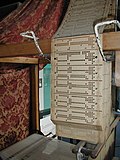been encoded by punching holes in the card, it was now a "punched card." For simplicity, this article will use the term punched card to refer to either...
11 KB (1,416 words) - 11:59, 25 February 2025
discusses how early card readers worked in some detail Computer programming in the punched card era List of IBM products#Punched card and paper tape equipment...
12 KB (1,384 words) - 00:54, 8 August 2025
A punched card (also known as a punch card or Hollerith card) is a stiff paper-based medium used to store and process digital or analog information through...
71 KB (7,398 words) - 18:34, 7 August 2025
Computer programming in the punched card era Operating systems timeline Computer Computer hardware Analog computer Analytical Engine Digital computer...
15 KB (987 words) - 02:34, 21 July 2025
History of computing hardware (redirect from History of the computer)
often used punched cards or punched paper tape for input and as the main (non-volatile) storage medium. Engineer Tommy Flowers joined the telecommunications...
170 KB (17,730 words) - 09:41, 29 July 2025
Unit record equipment (redirect from Punched card accounting)
media. Punched cards were used not only for data, but for a new application - computer programs, see: Computer programming in the punched card era. Unit...
60 KB (6,156 words) - 13:20, 4 August 2025
UNIVAC I (redirect from UNIVAC Card to Tape converter)
to the complex numerical calculations required of scientific computers. As such, the UNIVAC competed directly against punch-card machines, though the UNIVAC...
31 KB (3,630 words) - 18:11, 16 July 2025
Tabulating machine (category Punched card)
drive programmed machines such as Jacquard looms. "After some initial trials with paper tape, he settled on punched cards..." Hollerith used punched cards...
19 KB (2,261 words) - 04:12, 20 May 2025
controls on computer and peripheral devices. This Excludes Data Entry." The position has evolved from its beginnings in the punched card era. A Bureau of...
11 KB (1,169 words) - 22:08, 16 April 2025
IBM System/360 Model 20 (category 16-bit computers)
placed. The cards in the second hopper can contain punched cards to be read or blank cards to be punched. Two models were offered: Model A1: five card stackers...
19 KB (2,286 words) - 12:34, 4 August 2025
IBM 650 (category Computer-related introductions in 1954)
to the IBM 701 and IBM 702 computers, which were for scientific and business purposes respectively. It was also marketed to users of punched card machines...
38 KB (3,474 words) - 13:20, 6 July 2025
UNIVAC (category Defunct computer companies of the United States)
Computer) was a line of electronic digital stored-program computers starting with the products of the Eckert–Mauchly Computer Corporation. Later the name...
40 KB (4,564 words) - 23:44, 29 July 2025
IBM 2501 (category IBM punched card readers)
Punched card input/output Computer programming in the punched card era IBM Corporation (1967). IBM Field Engineering Theory of Operation: 2501 Card Reader...
4 KB (417 words) - 03:35, 7 May 2025
Control Data Corporation (category Defunct computer companies of the United States)
and then submit those pages to the computer. Since a typewritten page contains much more information than a punched card (which has essentially one line...
53 KB (6,661 words) - 09:01, 11 June 2025
Ferranti Pegasus (redirect from PEGASUS (computer))
printer or punched card input and output. The modular design with plug-in units of hardware did, however, make it very reliable by the standards of the day,...
14 KB (1,540 words) - 15:22, 23 July 2025
History of operating systems (redirect from History of computer operating systems)
peripheral devices like printers and punched paper card readers. The growing complexity of hardware and application programs eventually made operating systems...
36 KB (4,587 words) - 00:55, 21 April 2025
5 kilowatts for punched-card auxiliary equipment. Because the failure of any one of the thousands of tubes in a computer could result in errors, tube reliability...
25 KB (2,735 words) - 13:54, 18 July 2025
SNOBOL (redirect from SNOBOL programming language)
as normal on my JOB card — the first card in the deck, I, in BTL standards, punched my job and my name — SEXI Farber. One of the Comp Center girls looked...
22 KB (2,578 words) - 21:59, 28 July 2025
is produced. Programming languages provide various ways of specifying programs for computers to run. Unlike natural languages, programming languages are...
140 KB (14,116 words) - 06:41, 28 July 2025
the IBM 1400 series. Symbolic Programming System (SPS), was the assembler offered when IBM originally announced 1401 as a punched-card-only computer....
13 KB (1,147 words) - 20:05, 25 August 2024
IBM 7090 (category Computer-related introductions in 1959)
performance for the time. Printing and punched card I/O, however, employed the same modified unit record equipment introduced with the 704 and was slow...
30 KB (2,778 words) - 14:32, 31 July 2025
during the punch card era, when programs were typically written out by hand, to avoid ambiguity when the character was later typed on a card punch. The slashed...
18 KB (1,848 words) - 20:38, 12 July 2025
TECO (text editor) (redirect from Teco programming language)
character-oriented text editor and a programming language, that was developed in 1962 for use on Digital Equipment Corporation computers, and has since become available...
23 KB (2,619 words) - 09:13, 29 July 2025
MCM/70 (redirect from Micro Computer Machines)
wait times involved in submitting programs in punched card form for batch processing by a shared mainframe computer. In 1968, Kutt and Donald Pamenter started...
14 KB (1,609 words) - 11:36, 18 July 2025
Fortran (redirect from Fortran programming language)
machine to run the program (using punched cards for data input, and outputting results onto punched cards). Two versions existed for the 650s with a 2000...
105 KB (11,249 words) - 01:45, 19 July 2025
MIX (abstract machine) (redirect from MIX (computer programming))
hypothetical computer used in Donald Knuth's monograph, The Art of Computer Programming (TAOCP). MIX's model number is 1009, which was derived by combining the model...
18 KB (749 words) - 01:43, 19 October 2024
Characters per line (section In programming)
may shrink to 55–78 CPL. In computer technology, a line of an IBM punched card consisted of 80 characters. Widespread computer terminals such as DEC's...
11 KB (786 words) - 23:10, 27 July 2025
Assembly language (redirect from Assembler (computer programming))
many programmers. There are still certain computer programming domains in which the use of assembly programming is more common: Writing code for systems...
89 KB (9,904 words) - 17:24, 9 August 2025
Booting (redirect from Rebooting (computer))
computers of that era had similar features. For example, the IBM 1401 system (c. 1958) used a card reader to load a program from a punched card. The 80...
99 KB (11,296 words) - 19:18, 14 July 2025






















